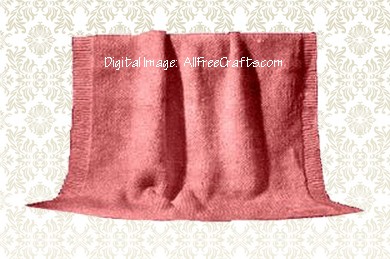Last updated on September 28th, 2015 at 11:34 pm
 Vintage Tam o’ Shanter Hat in Double Crochet
Vintage Tam o’ Shanter Hat in Double Crochet
For the model were used one skein of electric-blue knitting-worsted and a ball of gray Angora wool, with a hook large enough to carry the yarn easily.
Editor’s Note: This Tam O’Shanter hat pattern is reprinted here, in its entirety, but originally appeared in the 1918 Handbook of Wool Knitting and Crochet, published by the Needlecraft Publishing Company.
Because vintage and international crochet terms can differ, I am also including the original Handbook of Wool Knitting and Crochet directions for double crochet stitch, called doubles in this pattern.
Double Crochet: Having a stitch on needle, insert hook in work, take up thread and draw through, giving you two stitches on the needle; take up thread and draw through the two stitches. The abbreviation is d c. There are many variations of the double-crochet stitch; the slipper-stitch, or ribbed stitch, is formed by taking up the back horizontal loop or vein of each stitch in preceding row. A quite different effect is given when the hook is inserted under both loops.
Tam O’Shanter Pattern:
Make a chain of 3 stitches, join.
1. Seven doubles in ring.
2. Two doubles in each double, taking both veins of stitch.
3. A double in double, 2 in next; repeat.
4. A double in each of 2 doubles, 2 in next; repeat.
5. A double in each of 3 doubles, 2 in next; repeat.
Continue in this way, adding 1 double between widenings each row, until you have 30 doubles in each section – between widenings – or more, if a larger crown is desired.
33. A double in each of 7 doubles, miss 1; repeat.
34. A double in each of 6 doubles, miss 1; repeat.
35. A double in each of 2 doubles, miss 1; repeat.
36 to 45. A double in each stitch.
46, 47. With gray Angora wool, make a double in each stitch and fasten off the last row neatly.
Cover a large, flat button-mold with the blue wool: Make a chain of 3 stitches, turn, and in 2d stitch of chain make 8 doubles; make 2 doubles in each of 8 doubles, working in both veins of stitch; then make 1 double in 1st stitch, 2 in next, and repeat. Continue to work around and around, widening to keep the work flat, until you have a circle which will cover the button-mold, say 6 rounds; then work once around without widening, slip in the mold, * miss 1, a double in next, and repeat until the cover is closed.
For the edge of the button and the cord around top of band either the double chain may be made, an ordinary chain filled with double crochet, or – better still – the cord may be knotted by what is called the “fool’s delight” method – which seems a very sensible method, indeed:
Fool’s Delight
Take a length of the Angora wool six times as long as the cord is wanted to be; indeed, it will be better to start with a longer piece, for fear it may “take up” more rapidly than anticipated. Make a slip or half knot at one end of the yarn, pass the other end down through this to form a loop, then tie the ends of the yarn together. Hold this knot between thumb and forefinger of one hand (say the right), with the yarn which pulls through the half knot under the same hand, and the loop which was formed held on the forefinger, holding the yarn which does not pull in the left hand; pass the forefinger of left hand through the loop on right forefinger from front to back, catch up and draw through the non-pulling or left-hand thread – exactly as you would make a chain-stitch in crochet – transfer the knot which ties the two ends together to thumb and forefinger of left hand, keeping the loop over forefinger, and draw up the pulling yarn, or that passed originally through the half knot. Now the position of the loop, pulling yarn and knot is exactly the same in the left hand as formerly in the right. Continue by passing forefinger of right hand through the loop on left forefinger, catching up the non-pulling thread and drawing it through to form the new loop (on right forefinger again), transfer the knot from left hand to right, and pull up, repeating the process from beginning.
This is really a sort of double chain, and when one has learned to make it evenly and well – as may be done with a little practise – it will be found superior for bags, lingerie, and many other articles requiring a drawstring or a cord.
Sew this cord evenly around button and top of band, and the cap is completed.






Leave a Reply